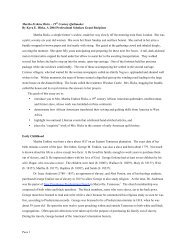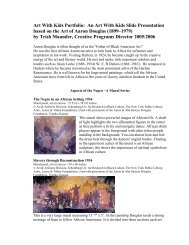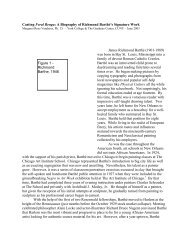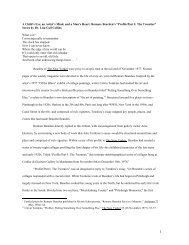Cuesta Benberry - The Anyone Can Fly Foundation, Inc.
Cuesta Benberry - The Anyone Can Fly Foundation, Inc.
Cuesta Benberry - The Anyone Can Fly Foundation, Inc.
Create successful ePaper yourself
Turn your PDF publications into a flip-book with our unique Google optimized e-Paper software.
to anybody but me, nor that I was operating in an important time, like the 1980s. Soyou were really in a serious … ‘Cause the 60s had passed and the quilters had goneunnoticed.CUESTA: Yes.FAITH: By both the African-American art scholars and the white ones, too. So there youwere. Into the 1980s and still sitting by the door waiting to find out what’s going tohappen.CUESTA: Right. Right. But then I was still working in 1980 but I would schedule maybeweekends or summer trips. It was surprising how people were so interested in African-American quilts. It was not … Most of the calls and invitations I received were fromwhite quilt dealers and from white institutions and museums and places like that. <strong>The</strong>ywere very, very interested.About this same time Maude Wahlman’s quilt, a little bit before that she had been astudent at Yale and she was one of the few students in the Black Studies Program. Ilearned about her work through a Yale alumni magazine and then followed it up withsome people that I knew and I got information.In the late 70s they had a big African-American crafts program in Memphis. She wasthere. So was Gladys-Marie Frye. That was when I learned that most of the research onAfrican-American quilts was coming from the academic community. None of the peoplethat I knew, who were basically quilt people, had any program about, or research effortabout African-American quilts. But then I met Roland Freeman , Gladys-Marie Frye,John Michael Blatch, and Maude. And they were the ones who were doing research onAfrican-American quilts.FAITH: How were they being received?CUESTA: Fine. Because New York is the media capital of the world. And because oftheir credentials and who they were. <strong>The</strong>n her first show was 10 Afro-American Quiltershttp://pegasus.cc.ucf.edu/~wahlman/quilters.html and they were from Mississippi. <strong>The</strong>quilts were. But I followed right along there and then at some later time other morequilt-oriented people, but not black, who weren’t scholars, like Maude and John MichaelBlatch who teaches at George Washington University….<strong>The</strong>y were all scholars. But then,more quilt-oriented people like Roberta Harten who was a teacher and Eli Leon who wasa dealer, and others began. And so then that whole area of African-American quiltsbecame a hot topic.FAITH: And what year was this?CUESTA: Well it was about ‘82/’83.FAITH: <strong>The</strong> ‘80s is just it.page 4






